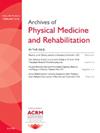Disparities in Postacute Care Utilization for Individuals with Traumatic Brain Injury 8255
IF 3.6
2区 医学
Q1 REHABILITATION
Archives of physical medicine and rehabilitation
Pub Date : 2025-04-01
DOI:10.1016/j.apmr.2025.01.054
引用次数: 0
Abstract
Objectives
To examine disparities in postacute care transitions across inpatient rehabilitation facility, skilled nursing facility, and home health care in individuals with traumatic brain injury.
Design
Secondary analysis of All-Payer Claims Data (2017-2021) from Virginia. We linked the individual-level data, with provider- and region-level data.
Setting
Acute hospitals and postacute settings in Virginia.
Participants
Patients with traumatic brain injury discharged to inpatient rehabilitation facility, skilled nursing facility, or home health care (N=8662).
Interventions
None.
Main Outcome Measures
Postacute settings, adjusting for patient-level covariates (sociodemographic characteristics, type of insurance, acute length of stay, Elixhauser comorbidity index, hospital-acquired complications), and region-level covariates (postacute availability, county ranking, and population). We constructed hierarchical generalized linear mixed models and Blinder-Oaxaca models for decomposing race and region effects.
Results
Approximately, 35% of our sample population did not receive any postacute care after hospitalization. For Hispanics and others, this rate was 46%. There were differences by race/ethnicity in types of postacute care settings. We also found variation in use of postacute care by region.
Conclusions
In the era of value-based payment models, it is important to examine long-term outcomes associated with postacute care transitions and develop care coordination models to eliminate disparities in access of postacute rehabilitation care.
Supported by the Commonwealth Neurotrauma Initiative (CNI): Transitions and Disparities in Care and Outcomes (TDCO) for Neurotrauma (Award # A262-90012).
Disclosures
none.
外伤性脑损伤患者急性期后护理利用的差异[j]
目的探讨创伤性脑损伤患者在住院康复机构、专业护理机构和家庭保健机构中急性后护理过渡的差异。设计对弗吉尼亚州所有付款人索赔数据(2017-2021)的二次分析。我们将个人层面的数据与供应商和地区层面的数据联系起来。在弗吉尼亚州设置急症医院和急症后医院。研究对象:创伤性脑损伤患者出院至住院康复机构、专业护理机构或家庭保健机构(N=8662)。主要结局指标:急性设置,调整患者水平协变量(社会人口学特征、保险类型、急性住院时间、Elixhauser合并症指数、医院获得性并发症)和地区水平协变量(急性后可用性、县排名和人口)。我们构建了层次广义线性混合模型和Blinder-Oaxaca模型来分解种族和地区效应。结果大约35%的样本患者在住院后没有接受任何急性后护理。对于西班牙裔和其他族裔,这一比例为46%。急性后护理环境的类型存在种族/民族差异。我们还发现不同地区使用急性后护理的差异。结论在以价值为基础的支付模式时代,重要的是研究急性后康复护理转变的长期结果,并制定护理协调模型,以消除急性后康复护理的可及性差异。由联邦神经创伤倡议(CNI)支持:神经创伤的护理和结果(TDCO)的过渡和差异(奖励# A262-90012)。
本文章由计算机程序翻译,如有差异,请以英文原文为准。
求助全文
约1分钟内获得全文
求助全文
来源期刊
CiteScore
6.20
自引率
4.70%
发文量
495
审稿时长
38 days
期刊介绍:
The Archives of Physical Medicine and Rehabilitation publishes original, peer-reviewed research and clinical reports on important trends and developments in physical medicine and rehabilitation and related fields. This international journal brings researchers and clinicians authoritative information on the therapeutic utilization of physical, behavioral and pharmaceutical agents in providing comprehensive care for individuals with chronic illness and disabilities.
Archives began publication in 1920, publishes monthly, and is the official journal of the American Congress of Rehabilitation Medicine. Its papers are cited more often than any other rehabilitation journal.

 求助内容:
求助内容: 应助结果提醒方式:
应助结果提醒方式:


